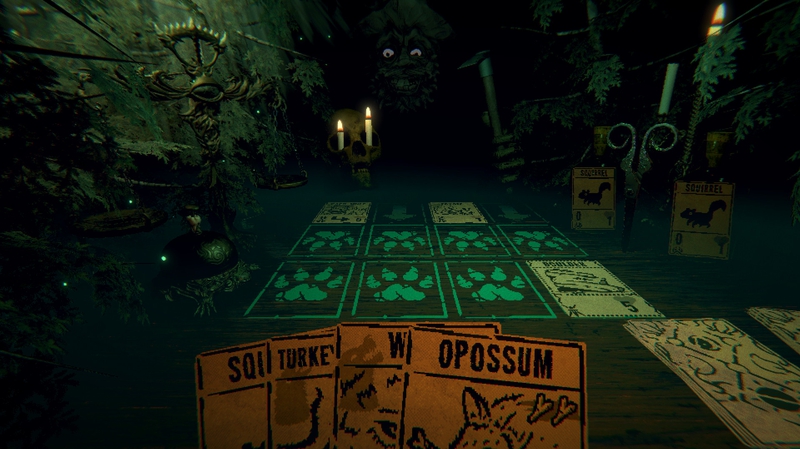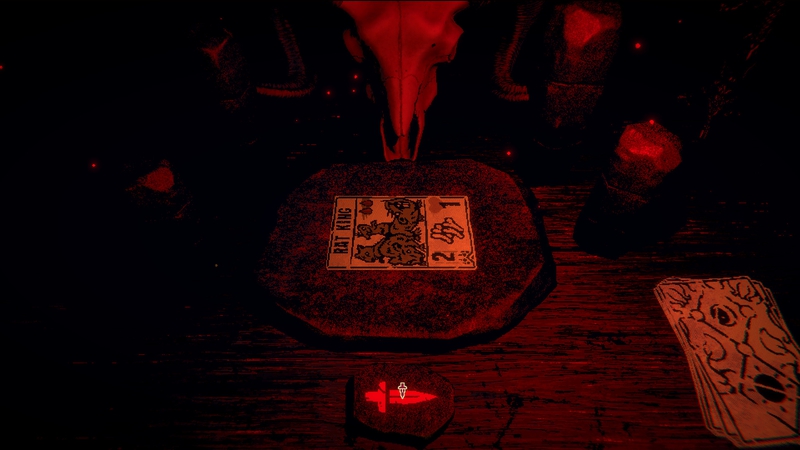One of the great things about horror is how versatile it is. You can sprinkle a little horror into pretty much anything to spice it up a little, and that’s particularly true in gaming, where genre boundaries tend to be relatively rigid. Swap soldiers for zombies, and your generic first-person shooter is now a horror game. Make your character a vengeful demon, and a role-playing game can cross over into horror with ease.
But what about the less obvious genres? Could you, for example, make a scary card game?
The answer is yes, as proven by the just-released Inscryption, which takes play concepts popularised by Magic the Gathering and evolved by videogame hits such as Hearthstone and Slay the Spire and drags them screaming into a world of backwoods terror and blood sacrifice.
At the start of the game, you’re sat at a table in a murky cabin, presumably in the middle of nowhere. Opposite you is…something. You’ll learn a lot more about your mysterious opponent as the hours pass, but for now, it’s simply a pair of glowing eyes staring out of the shadows and occasionally glimpsed gnarled hands. Between you, on the table, are the accouterments of a card battling game, and – to begin with – this is where the meat of the game lies. Literally.

You have a small deck of cards, each marked with woodland creatures. Each card has a defense and attack stat, and when two cards face each other, this is what determines who lives and dies. A Wolf card, for instance, deals out three damage but can only take two damage in return before it expires. If a card deals damage to an empty space, that damage is delivered directly to the player in question and is visualized as teeth added to a scale on the side of the playing area. Should your side of the scale tip too far – five teeth more than your opponent is all it takes – then you lose, and one of your two life-giving candles is snuffed out.
This much is the very basics of the genre, but uniquely disturbing wrinkles quickly emerge. Most cards come with a cost that must be met in order to be played. That Wolf card, for instance, requires a blood sacrifice. Two drops, to be precise, which means you must sacrifice two of your currently played cards to place the Wolf on the table. Others measure their entry to the game in bones, accrued whenever one of your cards dies for any reason. A pair of pliers offer a way to address an imbalance in the number of teeth on the scale, for those who aren’t squeamish about self-administered dentistry.
Right from the start, this is a game where your strategic currencies have a queasy air of butchery about them. You even have an inexhaustible supply of Squirrel cards for this exact purpose – innocent, useless little critters who exist only to be turned into blood and bone for your benefit.
Things, somehow, get darker still. You’re not simply playing endless card games for no reason. Your opponent – who you’ll come to know as “Leshy” – is holding you prisoner, forcing you to play. There’s a role-playing adventure element to the proceedings as you move a wooden totem along a path, board game style, triggering events and card battles. Leshy narrates these with bloodthirsty relish, sometimes wearing hideous wooden masks to play different characters. Things that may happen along your path include ravenous travelers who offer to warm one of your cards on their fire, strengthening it. However, you soon suspect that their random nature may turn against you.

Cards can also have sigils – marks that grant a particular bonus or ability. Sometimes one card will get to sacrifice another on an altar, gaining its ability. Sometimes you’ll be able to slice cards in two and stitch them together in new configurations, creating scarred hybrid creatures like some insane Frankenstein croupier. There’s a whole host of clever, intricate systems churning away in Inscryption’s guts, and part of the early pleasure of the game comes from discovering them and how they fit together.
That’s if you can trust your captor. The rules of the game are explained to you by Leshy, and the idea persists that he’s not an entirely reliable narrator. The game is never unfair, but nor are you allowed to feel like you know the boundaries of play with any confidence until much, much later. Through Leshy, the game continually comments on your actions and choices, mocks your mistakes, and generally treats you like a disappointing pupil at the mercy of a mercurial teacher. Both candles are extinguished if you lose two matches in any adventure, and Leshy drags you to some grisly side room to kill you. Death, for the player, is only ever temporary, however, and by falling to Leshy’s clutching hands, you gain a unique card, drawing stats and powers from whatever you had left, which goes into your deck and may be dealt out to you later.
The immediate question is whether you can ever escape this hellish cabin, and it’s here that Inscryption goes from being a really good card battling game with a ghoulish aesthetic and becomes something altogether more ingenious. You see, the game comes from Daniel Mullins, an indie developer best known for Pony Island. That game presented itself as a whimsical retro-styled endless runner, but then revealed itself to be a battle for your very soul against a possessed arcade machine.
Mullins is playing with similar ideas in Inscryption, with the card game as the compelling heart of a much larger, much stranger experience. You can get up from the table and explore Leshy’s cabin. There are objects strewn about the place that lead to escape room-style puzzles. Things learned in the card game prove relevant in the “real” world, and vice versa. One of your initial cards – a Stoat – even speaks to you, offering timely commentary, hints, and warnings regarding what Leshy has planned.
So can you escape from the cabin? It’s not revealing too much to answer in the affirmative, but doing so is far from the end of Inscryption’s dark spell and is, in fact, the start of something else entirely. The fact that this is a card game that can genuinely come with a spoiler warning regarding its story should give you an idea of just what a bizarre, unique, and effective creation this is.
None of this would work if the card game at the center of it all didn’t work, and it offers a punishing learning curve, to begin with. You will lose and die often, but each time you do, you’ll come away with a little more knowledge of how the game is won, and a card that will help move you closer to achieving that. Submit to this incremental pace, wallow in the gore-stained floorboard visual style along the way, and before long, you’ll be hooked on an intense and constantly surprising game that is almost impossible to pin down.
Horror in games tends to become calcified around certain tropes, but there’s never been anything like Inscryption before. It’s weird, gross, baffling, thrilling, fascinating, and deeply, deeply unnerving. How many card games can you say that about?






